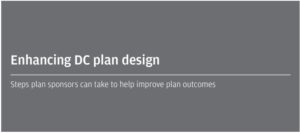 According to JPMorgan Asset Management, 68% of defined contribution (DC) plan participants are missing their retirement savings target. In a Whitepaper entitled “Enhancing DC Plan Design” the team at JPMorgan has identified a few steps sponsors can take to enhance participant outcomes. Not surprisingly, the JPMorgan roadmap mirrors The Plan Sponsor University (TPSU) model of the Ideal Plan design. That has become the leading model for Plan Sponsors in the United States.
According to JPMorgan Asset Management, 68% of defined contribution (DC) plan participants are missing their retirement savings target. In a Whitepaper entitled “Enhancing DC Plan Design” the team at JPMorgan has identified a few steps sponsors can take to enhance participant outcomes. Not surprisingly, the JPMorgan roadmap mirrors The Plan Sponsor University (TPSU) model of the Ideal Plan design. That has become the leading model for Plan Sponsors in the United States.
So what does it take to follow the blue print that many thought leaders seem to agree upon as the ideal plan design? First, Sponsors need to adopt auto features like auto enrollment and auto escalations. The results of implementing these features are undeniable and have a 95% approval rating in many polls and also create better outcomes. The JPMorgan folks offer the additional tips when evaluating and implementing auto features in what they deem to be the Keys to Success:
- Automatically enroll all employees, not just new hires
- Execute automatic enrollment annually for non-participants, rather than just a one-time sweep
- Kick-start savings by starting the default contribution rate at 6%, rather than at the typical rate of 3%
- Set a default automatic increase rate of 2%, rather than the typical rate of 1% to help ensure participants quickly reach an appropriate savings rate
The second point that JPMorgan stresses has to do with investment selection. Specifically, the study strongly emphasizes having appropriate target date fund (TDF) selections. This stands to reason as a wealth of recent research shows that the appropriate TDF outperforms do-it-yourselfers when it comes to fund performance.
For this aspect of creating the ideal plan the study shows that sponsors should focus on the following areas as the keys to success:
- Determine plan goals and objectives
- Compare and select a TDF that best aligns to the plan’s goals and objectives
- Establish a process for periodic review
- Document the process along the way
One of the most powerful and often overlooked areas is the concept of re-enrollment. According to the JPMorgan study:
A plan re-enrollment helps position both new and existing participants for retirement success by defaulting them into the plan’s qualified default investment alternative (QDIA), usually an age appropriate TDF, while still allowing those who want to take a more active role in choosing investments to opt out. Plan sponsors that conduct a re-enrollment typically see 49% to 97% of assets go into TDFs. Some plan sponsors, however, are reluctant to conduct a re-enrollment, due to anticipation of participant pushback. Our research indicates this is likely a misperception: 82% of participants are actually in favor of or at least neutral toward this strategy. In addition, 99% of those who have gone through a re-enrollment and allowed funds to be moved to a TDF are satisfied.
Keys to success
- Request participant-level asset allocation data from plan provider/recordkeeper
- Understand the facts:
- − ERISA safe harbor protection may be available for assets defaulted into a QDIA
- − Participants who want to make their own investment options can opt out
Limiting investment options in the core menu. Research provides support that more is not better when it comes to investment choices in a DC plan. “More specifically, the JPMorgan study concludes that more choices does not always lead to better diversification.”
Keys to success:
- Consider consolidating the entire core menu into three easy-to understand investment portfolios: diversified stocks, diversified bonds and diversified cash alternatives
- Understand the benefits:
- − Better diversification, with access to institutional quality strategies
- − Higher probability of better investment outcomes
Finally, another point similar to the TPSU Ideal Plan is to consider leveraging/modifying the employer match (stretching the match).
Many employers include a match as part of their benefits package. An employer match has the power to greatly increase the value of an employer-sponsored retirement savings account, while also providing a greater incentive for employees to contribute to the 401(k) plan. As shown in the chart below, 81% of participants feel the company match is a motivating factor in encouraging them to increase contributions.
Keys to success:
- Consider offering an employer match to encourage participant savings
- “Stretch” the match to increase participant savings without increasing plan costs. For example, rather than matching 100% of a participant’s savings of up to 4% of pay, a plan sponsor may motivate participants to save more by matching 50% of savings up to 8% of pay


